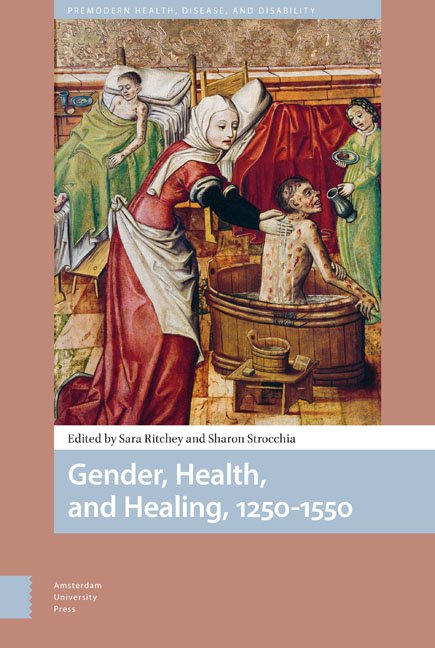Book contents
- Frontmatter
- Contents
- List of Figures and Tables
- Acknowledgments
- Abbreviations
- Introduction: Gendering Medieval Health and Healing: New Sources, New Perspectives
- Part 1 Sources of Religious Healing
- 1 Caring by the Hours: The Psalter as a Gendered Healthcare Technology
- 2 Female Saints as Agents of Female Healing: Gendered Practices and Patronage in the Cult of St. Cunigunde
- Part 2 Producing and Transmitting Medical Knowledge
- 3 Blood, Milk, and Breastbleeding: The Humoral Economy of Women's Bodies in Medieval Medicine
- 4 Care of the Breast in the Late Middle Ages: The Tractatus de passionibus mamillarum
- 5 Household Medicine for a Renaissance Court: Caterina Sforza's Ricettario Reconsidered
- 6 Understanding/Controlling the Female Body in Ten Recipes: Print and the Dissemination of Medical Knowledge about Women in the Early Sixteenth Century
- Part 3 Infirmity and Care
- 7 Ubi non est mulier, ingemiscit egens?: Gendered Perceptions of Care from the Thirteenth to Sixteenth Centuries
- 8 Domestic Care in the Sixteenth Century: Expectations, Experiences, and Practices from a Gendered Perspective
- 9 Bathtubs as a Healing Approach in Fifteenth-Century Ottoman Medicine
- Part 4 (In)fertility and Reproduction
- 10 Gender, Old Age, and the Infertile Body in Medieval Medicine
- 11 Gender Segregation and the Possibility of Arabo-Galenic Gynecological Practice in the Medieval Islamic World
- Afterword: Healing Women and Women Healers
- Contributors
- Index
6 - Understanding/Controlling the Female Body in Ten Recipes: Print and the Dissemination of Medical Knowledge about Women in the Early Sixteenth Century
Published online by Cambridge University Press: 23 June 2021
- Frontmatter
- Contents
- List of Figures and Tables
- Acknowledgments
- Abbreviations
- Introduction: Gendering Medieval Health and Healing: New Sources, New Perspectives
- Part 1 Sources of Religious Healing
- 1 Caring by the Hours: The Psalter as a Gendered Healthcare Technology
- 2 Female Saints as Agents of Female Healing: Gendered Practices and Patronage in the Cult of St. Cunigunde
- Part 2 Producing and Transmitting Medical Knowledge
- 3 Blood, Milk, and Breastbleeding: The Humoral Economy of Women's Bodies in Medieval Medicine
- 4 Care of the Breast in the Late Middle Ages: The Tractatus de passionibus mamillarum
- 5 Household Medicine for a Renaissance Court: Caterina Sforza's Ricettario Reconsidered
- 6 Understanding/Controlling the Female Body in Ten Recipes: Print and the Dissemination of Medical Knowledge about Women in the Early Sixteenth Century
- Part 3 Infirmity and Care
- 7 Ubi non est mulier, ingemiscit egens?: Gendered Perceptions of Care from the Thirteenth to Sixteenth Centuries
- 8 Domestic Care in the Sixteenth Century: Expectations, Experiences, and Practices from a Gendered Perspective
- 9 Bathtubs as a Healing Approach in Fifteenth-Century Ottoman Medicine
- Part 4 (In)fertility and Reproduction
- 10 Gender, Old Age, and the Infertile Body in Medieval Medicine
- 11 Gender Segregation and the Possibility of Arabo-Galenic Gynecological Practice in the Medieval Islamic World
- Afterword: Healing Women and Women Healers
- Contributors
- Index
Summary
Abstract
In 1529, a book called Dificio di ricette was published in Venice. It included ten recipes concerned with the female body, which aimed to instruct readers but also allowed them to control the female body, especially where reproduction was concerned. This book initiated a new trend of vernacular medical texts directed to a broad audience; it described practices, prescribed models, and served as a tool for readers to create their own experiments. When translated into other vernaculars, recipes were adapted to new readerships, with publishers and translators closely engaging and transforming their texts, reshaping the knowledge they diffused. By encouraging the discussion of these matters more openly in the vernacular, recipes potentially allowed female readers to actively regulate their own bodies.
Keywords: books of secrets, medical recipes, translation, vernacular medicine, reproduction
In 1529, an anonymous book called Opera nuova intitolata Dificio di ricette, or ‘New Work called House of Recipes’, was published in Venice. It was a cheaply printed in-octavo booklet, containing miscellaneous recipes to aid and amuse the reader in his or her everyday life. It addressed the readership in an informal tone, and its preface underscored its utility, since it had been published for the ‘benefit of all people’ (‘beneficio universale’). The Dificio di ricette was the first printed book of secrets in Italy, inaugurating more than a century of best-selling print compilations of recipes in Europe, and deeply influencing subsequent works by Alessio Piemontese, Leonardo Fioravanti, Giambattista Della Porta, and others. The Dificio promised to reveal ‘secrets’ to its readers in the form of straightforward recipes illustrated by woodcuts. Among the dozens of magic tricks, cosmetic, culinary, and medical recipes contained in the collection, the reader was presented with ten practical secrets about women's bodies. These recipes aimed to instruct, but also allowed the reader to control the female body, especially where fertility and reproduction were concerned. Thanks to this book, the periodicity, quality, and quantity of menstruation could be regulated, conception assured, and questions about future children answered.
Having served as an inspiration for most books of secrets that followed it, the Dificio continued to be printed well into the nineteenth century.
- Type
- Chapter
- Information
- Gender, Health, and Healing, 1250–1550 , pp. 167 - 188Publisher: Amsterdam University PressPrint publication year: 2020
- 3
- Cited by



